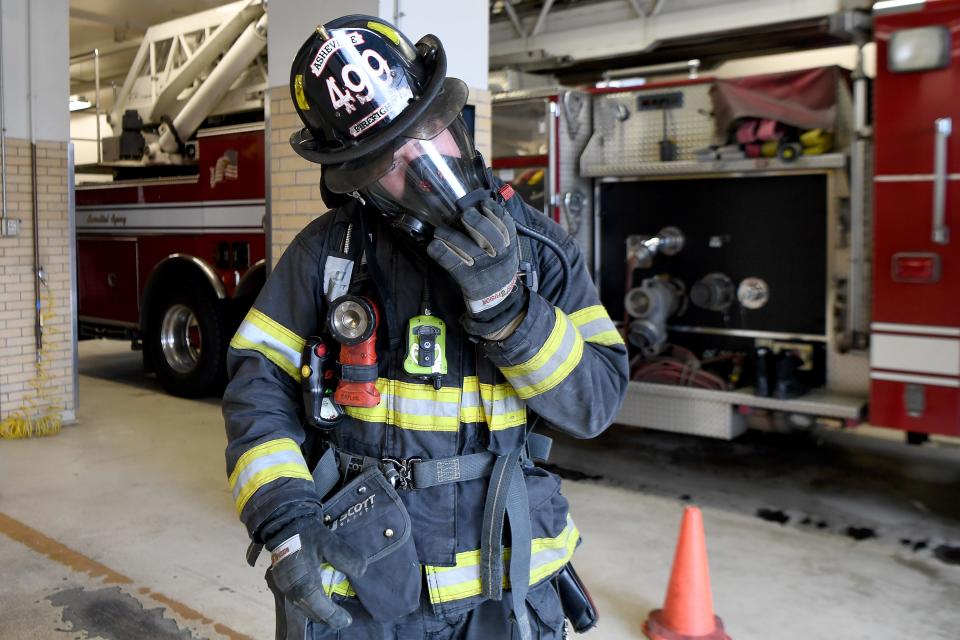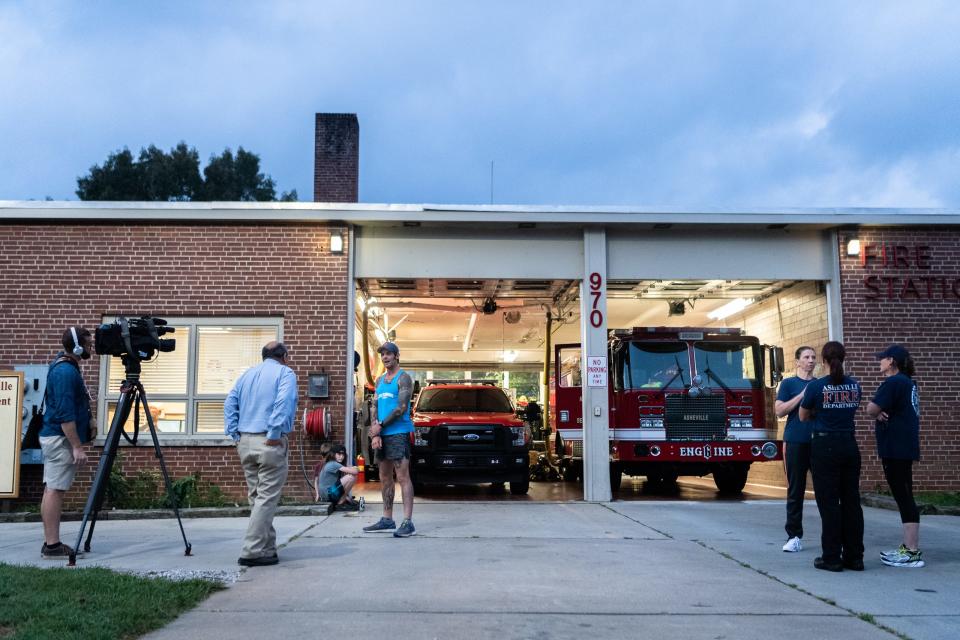WHO declares firefighting is a cancer risk; how this affects Asheville firefighters
ASHEVILLE - After 15 years working as an Asheville Fire Department engineer, Ben Brickhouse was diagnosed with an “aggressive” form of prostate cancer in September 2019 and had to take a medical retirement.
While with cancer, it can be hard to cite a specific cause, the occupational exposure Brickhouse and other firefighters face on the job is now considered “carcinogenic to humans” by the International Agency for Research on Cancer, the cancer research agency of the World Health Organization.
This marks a notable change in classification from “possibly carcinogenic,” as firefighter exposure was previously classified, according to a release by the National Fire Protection Agency. Travis McGaha, an assistant fire marshal with the Concord Fire Department and co-founder of the North Carolina Firefighter Cancer Alliance, says this reclassification is “going to be huge.”
“Occupational exposure as a firefighter is complex and includes a variety of hazards resulting from fires and non-fire events,” the IARC analysis states.
“Firefighters can be exposed to combustion products from fires (like polycyclic aromatic hydrocarbons and particulates), building materials (like asbestos), chemicals in firefighting foams (like per- and polyfluorinated substances), flame retardants, diesel exhaust, and other hazards.”
Cancer: Asheville firefighters face job danger even deadlier than fire

Changes in the types of fires and building materials have resulted in substantial changes in firefighter exposures over time, the study notes. In the past few decades, homes and furniture have changed from wood and natural fibers such as cotton and wool to synthetics and plastics, which release carcinogens while burning that are hazardous to firefighters.
More news: Asheville fire investigator dies from cancer, eligible for line of duty benefits
Impact to Asheville firefighters
A building full of burning materials is not the only carcinogens these firefighters face – some are wrapped around their bodies. PFAS, a hazard listed by IARC, is a chemical placed in firefighting gear to protect firefighters from flammable chemicals. Although firefighters have stepped away from using firefighting foams, PFAS remain in their gear.

Firefighter: In historic move, retired Asheville firefighter's cancer death ruled in 'line of duty'
"Almost every single set of turnout gear right now contains PFAS," said Scott Mullins, president of Asheville Fire Fighters Association.
"The reality is that we haven’t found a gear that is completely safe. Unfortunately, our gear has that in it, but we do the best we can at Asheville to keep our gear clean of products of combustion. I think we are doing the best we can at Asheville with what we have."
“The fact that there is a chemical out there that causes cancer and we as firefighters are exposed to it more than the general public many times over, makes me mad because our battalion chiefs and our safety officers are supposed to be on top of that kind of stuff,” said Brickhouse, noting that because PFAS is so new, it's only been in the past few years that firefighters have gained more knowledge of it.
Cancer is the leading cause of death among firefighters, according to the Firefighter Cancer Support Network and the International Association of Firefighters.
More: Asheville firefighter dies of kidney cancer at age 34
In the past four years, seven active or retired Asheville Fire Department firefighters have been diagnosed with cancer, four of whom died due to the illness, according to the association. Some of the families of these firefighters who died received disability benefits, like the family of Jim Knoupf, a retired Asheville Fire Department engineer who died of cancer in Aug 2021.
When applying for disability or a worker’s compensation lawsuit, a doctor must provide a statement that in their medical opinion, the cancer was caused by the person’s job. McGaha is hopeful that this new WHO classification will prompt doctors to ask more questions that will connect their patient’s diagnoses with carcinogens firefighters are exposed to on duty; and in return, help more cancer-diagnosed firefighters receive compensation.
More related news: An Asheville fire marshal died of cancer. Officials rule she died in the line of duty.

“One of the things we are seeing is, a lot of times doctors will not know that their patients are firefighters, whether it be a full-time paid firefighter or even someone who works in a volunteer department,” McGaha said.
Mullins of AFFA says this classification by WHO is going to be helpful for receiving needed funding to keep the "strong" NC legislation, that protects Asheville firefighters with claims related to cancer diagnosis, on the books."
“We have a very strong piece of legislation that covers firefighters when they get cancer, and the funding for that legislation expires after two years," Mullins said.
"I believe that this is going to be very helpful for us in the future to receive funding for our cancer legislation. In that way, we are very excited about this news and we are very fortunate to have good legislation in place that protects firefighters right now if they get cancer.”
According to an N.C. statute, firefighters have died in the line of duty if they die as a direct result of four cancers "occupationally related to firefighting": mesothelioma, testicular cancer, intestinal cancer and esophageal cancer.
Yet, the IARC found connections between occupational exposure as a firefighter and cancers that are absent from this list. The WHO cancer agency stated a “casual association exists” between firefighter exposure and bladder cancer. IARC found “credible positive associations” between exposure and melanoma, non-Hodgkin lymphoma, and colon and prostate cancers. However, the study considered the evidence for these last four cancers to be “limited.”
What the study found
The IARC analysis is based on the findings of 25 scientists from eight countries who evaluated a total of 52 cohort and case-control studies, 12 case reports, and seven meta-analyses to arrive at this conclusion. The results were published by the IARC on June 30.
“Occupational exposure as a firefighter was classified as ‘carcinogenic to humans based on ‘sufficient’ evidence for cancer in humans,” the IARC states, noting that this evaluation applies to all firefighters, including volunteers, regardless of gender. The meta-analysis estimated a 58% higher risk for mesothelioma among firefighters compared to mostly general populations.
More:Third Asheville Fire Department firefighter dies of cancer in less than two years
“We have seen a big shift in probably the last 10 years or less in the fire services as higher-ups, your company officers and your chief-level officers, are starting to understand that cancer is a big deal,” McGaha said.
“What this is doing is, it’s validating that and it's giving more importance to this factor. And so those folks who haven’t been listening up until this point will be more motivated to listen to it. There’s more science backing up what we already knew.”
Cancer epidemic: Asheville Fire Department death brings greater attention to cancer epidemic among firefighters
The Asheville Fire Department does have procedures in place to help mitigate the risks firefighters face. This includes decontamination of uniforms as soon as firefighters clear a fire, wearing Self-Contained Breathing Apparatuses (SBA) while on the scene, and washing uniforms in a commercial grade washing machine after returning to the station. The fire department has also installed “plymovents,” which reduce exposure to harmful fumes by sucking the diesel exhaust out of the station when the trucks roll out.
Ryley Ober is a news intern with the Asheville Citizen Times, part of the USA Today Network. News tips? Email her at ROber@gannett.com and follow her on Twitter @ryleyober
This article originally appeared on Asheville Citizen Times: World Health Organization shows firefighter exposure is carcinogenic

